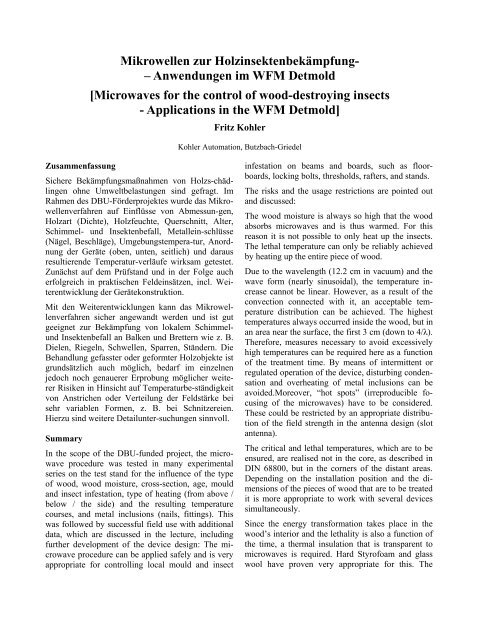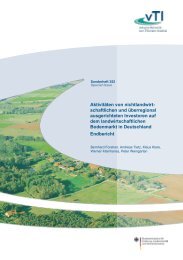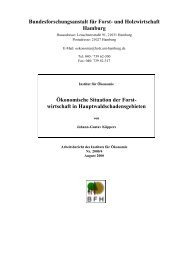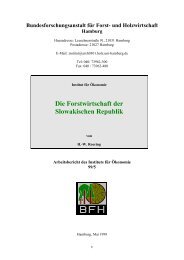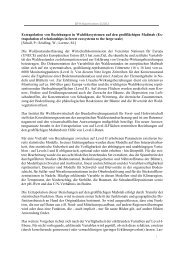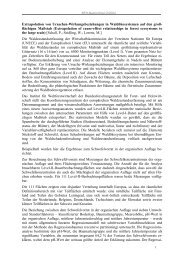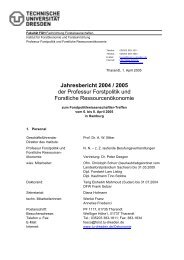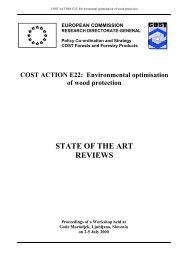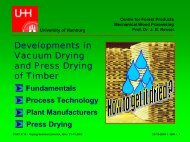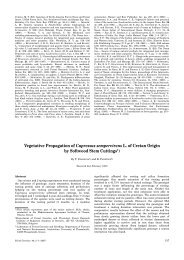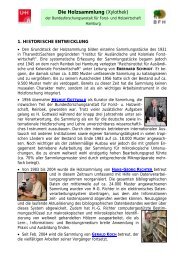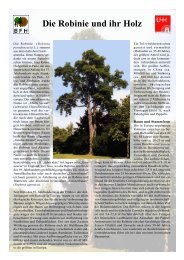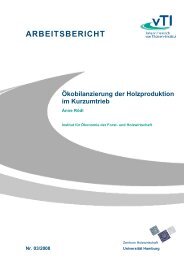Microwaves for the control of wood-destroying insects
Microwaves for the control of wood-destroying insects
Microwaves for the control of wood-destroying insects
You also want an ePaper? Increase the reach of your titles
YUMPU automatically turns print PDFs into web optimized ePapers that Google loves.
Mikrowellen zur Holzinsektenbekämpfung-<br />
– Anwendungen im WFM Detmold<br />
[<strong>Microwaves</strong> <strong>for</strong> <strong>the</strong> <strong>control</strong> <strong>of</strong> <strong>wood</strong>-<strong>destroying</strong> <strong>insects</strong><br />
- Applications in <strong>the</strong> WFM Detmold]<br />
Fritz Kohler<br />
Kohler Automation, Butzbach-Griedel<br />
Zusammenfassung<br />
Sichere Bekämpfungsmaßnahmen von Holzs-chädlingen<br />
ohne Umweltbelastungen sind gefragt. Im<br />
Rahmen des DBU-Förderprojektes wurde das Mikrowellenverfahren<br />
auf Einflüsse von Abmessun-gen,<br />
Holzart (Dichte), Holzfeuchte, Querschnitt, Alter,<br />
Schimmel- und Insektenbefall, Metallein-schlüsse<br />
(Nägel, Beschläge), Umgebungstempera-tur, Anordnung<br />
der Geräte (oben, unten, seitlich) und daraus<br />
resultierende Temperatur-verläufe wirksam getestet.<br />
Zunächst auf dem Prüfstand und in der Folge auch<br />
erfolgreich in praktischen Feldeinsätzen, incl. Weiterentwicklung<br />
der Gerätekonstruktion.<br />
Mit den Weiterentwicklungen kann das Mikrowellenverfahren<br />
sicher angewandt werden und ist gut<br />
geeignet zur Bekämpfung von lokalem Schimmelund<br />
Insektenbefall an Balken und Brettern wie z. B.<br />
Dielen, Riegeln, Schwellen, Sparren, Ständern. Die<br />
Behandlung gefasster oder ge<strong>for</strong>mter Holzobjekte ist<br />
grundsätzlich auch möglich, bedarf im einzelnen<br />
jedoch noch genauerer Erprobung möglicher weiterer<br />
Risiken in Hinsicht auf Temperaturbe-ständigkeit<br />
von Anstrichen oder Verteilung der Feldstärke bei<br />
sehr variablen Formen, z. B. bei Schnitzereien.<br />
Hierzu sind weitere Detailunter-suchungen sinnvoll.<br />
Summary<br />
In <strong>the</strong> scope <strong>of</strong> <strong>the</strong> DBU-funded project, <strong>the</strong> microwave<br />
procedure was tested in many experimental<br />
series on <strong>the</strong> test stand <strong>for</strong> <strong>the</strong> influence <strong>of</strong> <strong>the</strong> type<br />
<strong>of</strong> <strong>wood</strong>, <strong>wood</strong> moisture, cross-section, age, mould<br />
and insect infestation, type <strong>of</strong> heating (from above /<br />
below / <strong>the</strong> side) and <strong>the</strong> resulting temperature<br />
courses, and metal inclusions (nails, fittings). This<br />
was followed by successful field use with additional<br />
data, which are discussed in <strong>the</strong> lecture, including<br />
fur<strong>the</strong>r development <strong>of</strong> <strong>the</strong> device design: The microwave<br />
procedure can be applied safely and is very<br />
appropriate <strong>for</strong> <strong>control</strong>ling local mould and insect<br />
infestation on beams and boards, such as floorboards,<br />
locking bolts, thresholds, rafters, and stands.<br />
The risks and <strong>the</strong> usage restrictions are pointed out<br />
and discussed:<br />
The <strong>wood</strong> moisture is always so high that <strong>the</strong> <strong>wood</strong><br />
absorbs microwaves and is thus warmed. For this<br />
reason it is not possible to only heat up <strong>the</strong> <strong>insects</strong>.<br />
The lethal temperature can only be reliably achieved<br />
by heating up <strong>the</strong> entire piece <strong>of</strong> <strong>wood</strong>.<br />
Due to <strong>the</strong> wavelength (12.2 cm in vacuum) and <strong>the</strong><br />
wave <strong>for</strong>m (nearly sinusoidal), <strong>the</strong> temperature increase<br />
cannot be linear. However, as a result <strong>of</strong> <strong>the</strong><br />
convection connected with it, an acceptable temperature<br />
distribution can be achieved. The highest<br />
temperatures always occurred inside <strong>the</strong> <strong>wood</strong>, but in<br />
an area near <strong>the</strong> surface, <strong>the</strong> first 3 cm (down to 4/λ).<br />
There<strong>for</strong>e, measures necessary to avoid excessively<br />
high temperatures can be required here as a function<br />
<strong>of</strong> <strong>the</strong> treatment time. By means <strong>of</strong> intermittent or<br />
regulated operation <strong>of</strong> <strong>the</strong> device, disturbing condensation<br />
and overheating <strong>of</strong> metal inclusions can be<br />
avoided.Moreover, “hot spots” (irreproducible focusing<br />
<strong>of</strong> <strong>the</strong> microwaves) have to be considered.<br />
These could be restricted by an appropriate distribution<br />
<strong>of</strong> <strong>the</strong> field strength in <strong>the</strong> antenna design (slot<br />
antenna).<br />
The critical and lethal temperatures, which are to be<br />
ensured, are realised not in <strong>the</strong> core, as described in<br />
DIN 68800, but in <strong>the</strong> corners <strong>of</strong> <strong>the</strong> distant areas.<br />
Depending on <strong>the</strong> installation position and <strong>the</strong> dimensions<br />
<strong>of</strong> <strong>the</strong> pieces <strong>of</strong> <strong>wood</strong> that are to be treated<br />
it is more appropriate to work with several devices<br />
simultaneously.<br />
Since <strong>the</strong> energy trans<strong>for</strong>mation takes place in <strong>the</strong><br />
<strong>wood</strong>’s interior and <strong>the</strong> lethality is also a function <strong>of</strong><br />
<strong>the</strong> time, a <strong>the</strong>rmal insulation that is transparent to<br />
microwaves is required. Hard Styr<strong>of</strong>oam and glass<br />
wool have proven very appropriate <strong>for</strong> this. The
devices must be exactly oriented <strong>for</strong> an optimal<br />
treatment period. As a consequence, an intensive<br />
user training is required, with increasing experience<br />
substantial shorter treatment periods are required.<br />
Even if <strong>the</strong> device manufacturers have fulfilled all<br />
safety regulations, <strong>the</strong> entire safety chain can only be<br />
ensured by <strong>the</strong> user.<br />
The heat-generating field strength <strong>of</strong> microwaves<br />
decreases according to <strong>the</strong> square <strong>of</strong> <strong>the</strong> distance.<br />
Microwave devices are optimised by means <strong>of</strong> construction<br />
measures such that <strong>the</strong> devices can be positioned<br />
closer to <strong>the</strong> interior corners and edges, <strong>the</strong><br />
areas which are to be treated, in difficult installation<br />
locations (e.g. rafters on ro<strong>of</strong> beams). In addition,<br />
adaptation to beam thickness can be made with<br />
swivelling reflectors. In this manner scattering losses<br />
are avoided to a great degree.<br />
Treatment costs are also dealt with. They are basically<br />
a function <strong>of</strong> <strong>the</strong> dimensions, type <strong>of</strong> <strong>wood</strong><br />
(density), <strong>wood</strong> moisture, device arrangement<br />
(heating from above / from below / from <strong>the</strong> side)<br />
and <strong>the</strong> ambient temperature. But <strong>the</strong> installation site<br />
and position (e.g. in a church tower) can influence<br />
<strong>the</strong> costs substantially. However, it can basically be<br />
stated that a microwave <strong>control</strong> measure is normally<br />
more reasonable than restoration. Fur<strong>the</strong>rmore,<br />
judging from our experience, both 50€/m and<br />
500€/m can be seriously calculated and economical.<br />
Costs <strong>for</strong> <strong>the</strong> treatment <strong>of</strong> surfaces (floor-boards,<br />
parquet flooring) are <strong>of</strong> <strong>the</strong> same order <strong>of</strong> magnitude<br />
(from 50€/m²).


